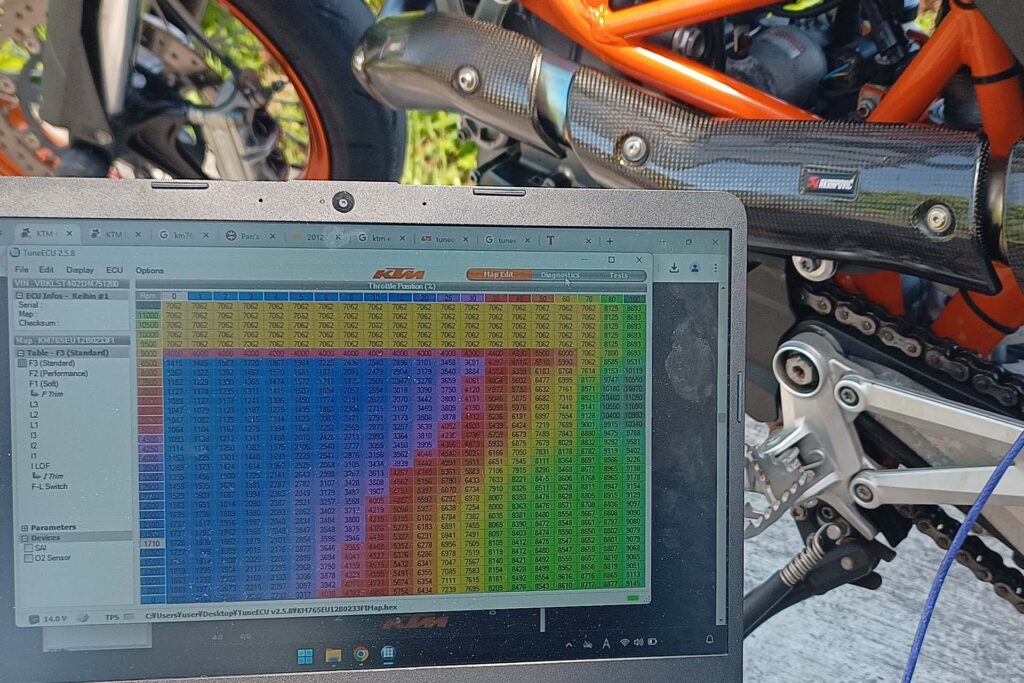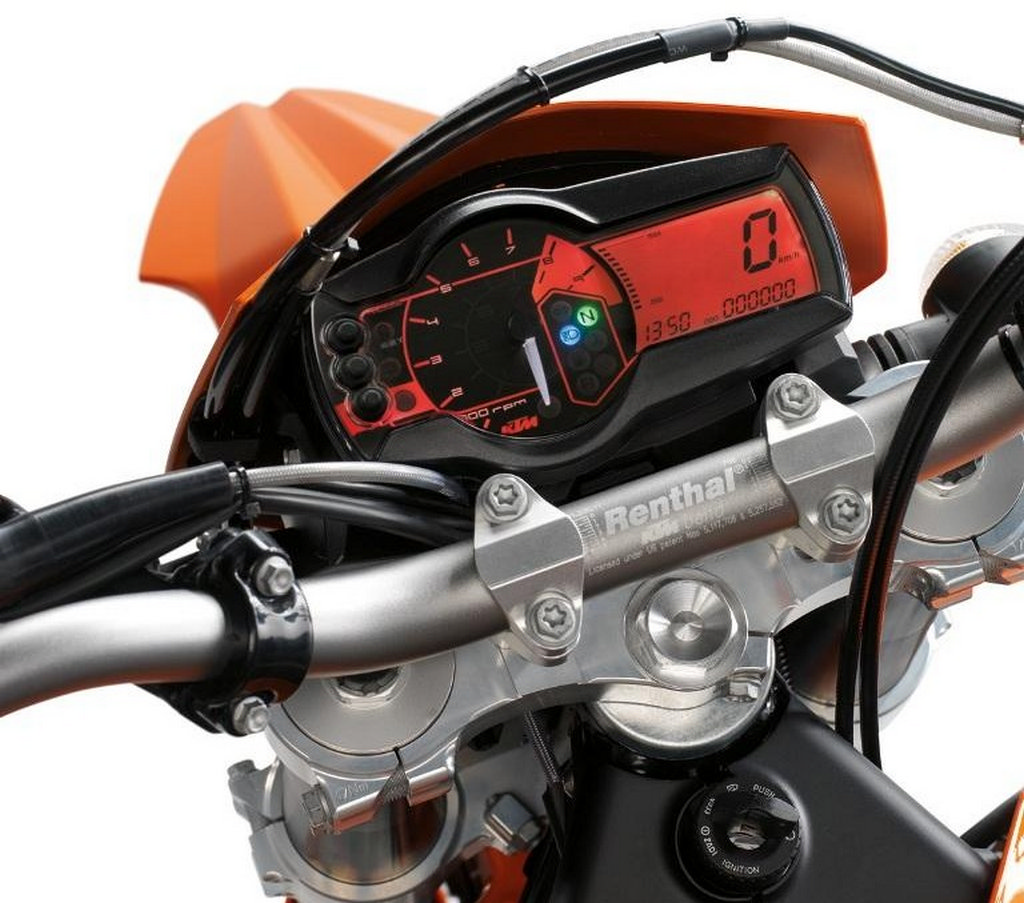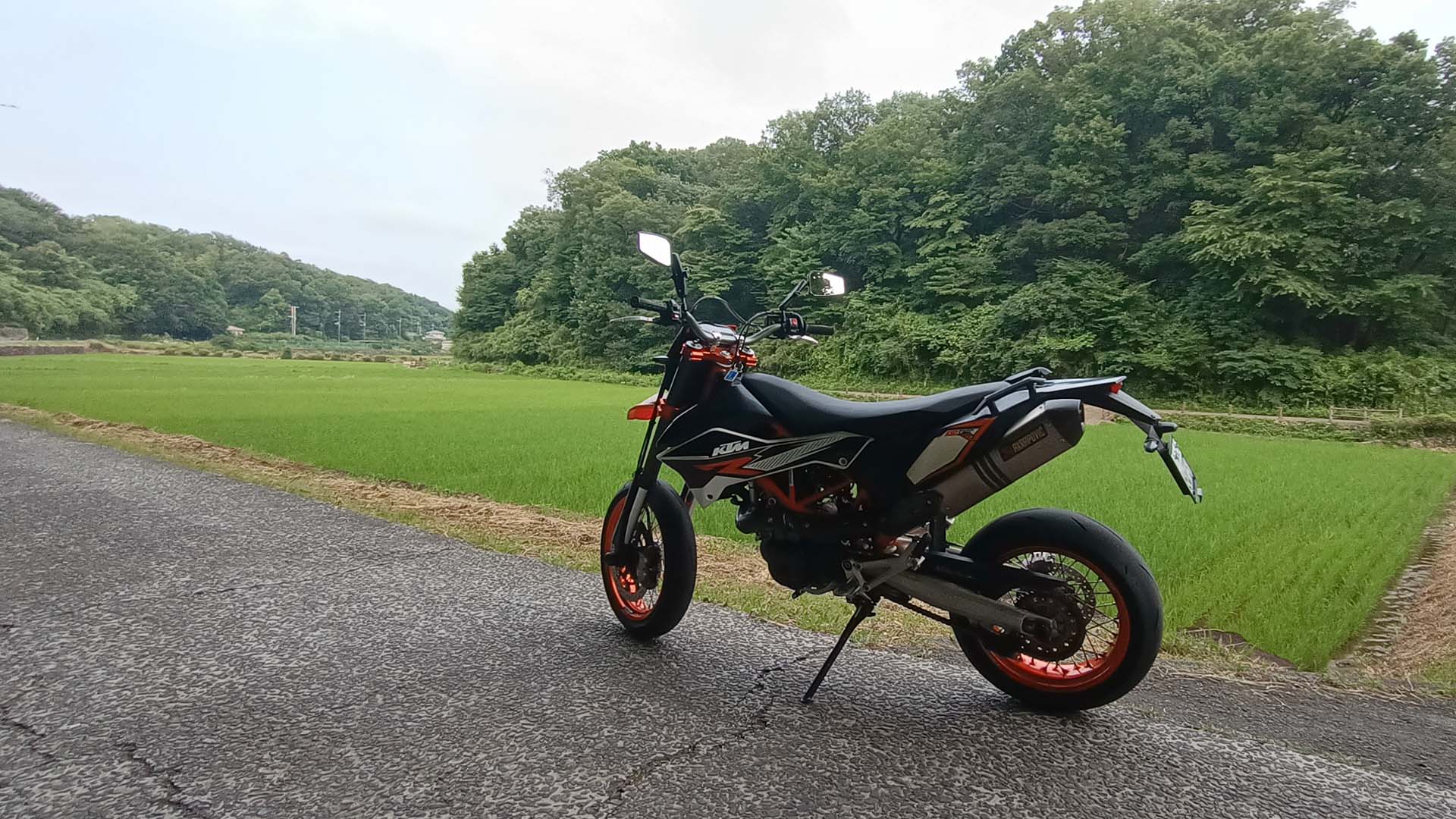Model evolution from 640SM to 690SMC and differences
KTM’s 640 LC4 SuperMoto (640SM) was a hard-hitting big-single supermoto from the late 1990s through the 2000s, known for its 625cc class carbureted single-cylinder engine that produced about 54 hp and was known for its intense vibration and punchy acceleration.Its successor, the 690SMC, introduced in 2007, featured an updated engine with a displacement of 653.7 cc (later expanded to 690 cc) and EFI (electronic fuel injection) fuel delivery.The body was redesigned with a new trellis frame and a plastic subframe for the fuel tank at the rear.As a result, the engine weight has been reduced by approximately 3 kg, resulting in an overall vehicle weight reduction of 8 kg.The new LC4 engine has lower vibration and more power, and the 690SMC’s specs are approximately 63 hp for the initial model and 67 hp for the 690cc version from 2012 onward, far exceeding the 49 to 54 hp of the former 640SM.With enhanced equipment such as Brembo radial-mount brakes, WP suspension, and a slipper clutch, the new 690SM has reached a level of perfection that has earned it the reputation as “the king of road-oriented supermotos.
Design philosophy of the LC4 engine and its unique single-cylinder character
KTM’s LC4 engine (abbreviation for Liquid-Cooled 4-stroke) was developed based on the design philosophy of “aiming for light weight and high power output in a large-displacement single.Conventionally, the practical upper limit for single-cylinder engines in off-road and dual-purpose motorcycles has been around 500cc.However, KTM dared to try a single-cylinder engine over 600 cc, and the first 620/640 had a rough side that generated such violent vibrations that it was said to be “like a paint mixer.Nevertheless, the instantaneous torque of the single-cylinder and the lightness of its simple construction attracted enthusiasts.
The new generation LC4s in the 690 series are designed to achieve even higher output while suppressing such vibrations.For example, the 654cc engine introduced in 2008 was equipped with a balancer shaft, and the engine mounts and internal design were optimized to reduce vibration to such an extent that “tooth fillings do not pop out even over long distances.Plug (dual spark) ignition for improved combustion and electronically controlled throttle (DBW) for precise fuel control, resulting in the strongest production single 70 hp. 2019 will also finally feature a two-axle balancer, with “two balancer shafts and twin spark heads,Ride-by-wire technology eliminates any unwanted vibrations”.In this way, each generation of the LC4 engine has improved both vibration characteristics and power output, and has evolved while maintaining its unique presence as a single cylinder.
The 2013 690 SMC R with “primitive radicalism
Among the many 690SMC/R models, the 2013 model has a special meaning for veterans.This is because it is the “last primitive” extreme model without any of the advanced electronic devices that were installed in the 2014 and later models.(For the 2014 model year, the car was equipped with dual sparks, electronic throttle, and 2-channel ABS as standard equipment to comply with European regulations.)In contrast, the 690SMC up to the 2013 model is a pure rider-driven machine without any such intervention.
First of all, because it is not equipped with ABS, braking is left 100% to the rider’s skill.Sudden braking on-road and the rear slide (so-called “back drift”) characteristic of super motos can be done as desired, unencumbered by electronic control.In fact, the 2014 model has a mode for professionals that allows the rider to lock the rear wheels while leaving the ABS on only the front wheels, but the 2013 model has no ABS to begin with, leaving the rider completely in control of the bike.Also, because it does not use an electronically controlled throttle (ride-by-wire), the engine’s response to throttle operation is mechanically direct.While recent electronic throttles are smooth and easy to use, veterans may find them lacking or slightly delayed.In this respect, the 2013 model with the cable-type throttle offers a primitive feeling of “a flick of the wrist leading directly to violent acceleration.The single plug ignition instead of twin plugs also makes the combustion and output characteristics rougher and the response sharper, for better or worse.
Furthermore, this model was also the last generation for which the ECU (engine control unit) map could be rewritten; since 2014, measures have been taken to software-lock modifications, preventing users from changing the fuel map without permission.On the other hand, custom mapping is relatively easy with tools such as TuneECU for the 08-13 models, and there is still the fun of making your own adjustments for intake/exhaust modifications and pre-existing conditions.This “freedom from electronic devices” is another reason why older models are loved by enthusiasts.

In short, the 2013 690SMC is the last pure sports single-cylinder that combines the ruggedness of the early LC4 with the increased power of the new generation LC4 at a higher dimension and without any extra electronic intervention.This sharp appeal is what makes the 2013 model so special to veteran KTM fans.
Weaknesses of LC4 machines: vibration, stall problems and practical issues
However, being “radical” also comes with practical compromises and challenges.The former 640LC4 series was famous for its terrible vibration, and even the 690 series, though improved, is not as quiet as the multi-cylinder engines. 690SMC-R is smooth enough for long-distance riding, but it still has the characteristic single pulse and vibration at high rpm, and some riders feel numbness in their hands and feet after riding for a long time.Some riders may feel numbness in their limbs after riding for a long time.In terms of the chassis, the seat height is extremely high at around 910mm, and some riders have described the poor leg room and hardness of the seat as “almost torturous.The fuel tank capacity is also low at around 12 liters, and the cruising range is not long (although it has improved compared to the early model, which is reported to be able to run at a fuel economy of 65 mpg, or approximately 23 km per liter).
Of particular note is the problem of stalling at low engine speeds.Owners of the early FI model 690SMC often reported that the engine would suddenly stall when starting from a stoplight or driving in traffic.The cause of this problem could be too low fuel mixture at idling (extremely lean setting to comply with environmental regulations) or poor adjustment of the throttle body.Some known countermeasures include remapping the ECU or installing a “fuel dongle” at the O2 sensor connection to correct the fuel mixture to a higher level at low throttle opening.In fact, there have been cases where stalls have been resolved by volunteers by replacing the thermostat switch with one that operates at a lower temperature, by running the cooling fan earlier to prevent heat leakage, and by adjusting the idle screw to stabilize the air-fuel ratio.In this way, a certain amount of knowledge and time and effort are required to finish the 690 SMC to perfection, including dealing with a pre-existing condition such as “the stall stops when the clutch is depressed just before stopping the car.
But KTM’s racy flavor and sharp specifications are inextricably linked to this inconvenience, as KTM itself has said of the 690SMC-R (which returns for 2019), “A high degree of electronic sophistication does not diminish its excitement and focus.Even its electronically controlled successor “has lost none of its ruggedness,” and the 690SMC itself has always been a hard-edged machine that prioritizes excitement over practicality.This series embodies the KTM spirit of “READY TO RACE,” including its stoic character that challenges the rider to the extreme.
We have a KTM 690SMC-R 2013 as our R&D vehicle and are happy to discuss tuning options for each model.Please feel free to contact us for the latest used market prices.We will be happy to suggest a bike that fits your taste and budget.
KTM Meter Clock Setting Procedure
KTM motorcycles from that era reset the meter clock when the battery is removed. Below is the procedure for setting the time.
Applicable Models
Primarily applies to models equipped with LCD meters that have orange backlighting
- 950 / 990 Adventure: 2003 – 2013
- 990 Super Duke / R: 2005 – 2013
- 950 / 990 Supermoto (SM, SMT, SMR): 2005 – 2013
- 690 Supermoto / SM R: 2007 – 2009
- 690 Enduro / R: 2008 – 2018
- 690 SMC / R: 2008 – 2017
- 690 Duke: 2008 – 2015
- 125 / 200 / 390 Duke: 2011 – 2016
- RC 125 / 200 / 390: 2014 – 2016

Preparation
- Park the motorcycle
- Turn the ignition key to the “ON” position
Procedure
- Switch to ODO mode display
Press the MODE button several times to display ODO mode - Enter time setting mode
Press and hold the MODE and SET buttons simultaneously.
When the time display starts blinking, you have entered setting mode - Set the hour
Press the MODE button to adjust the hour - Set the minutes
Press the SET button to adjust the minutes - Complete the setting
Press and hold the MODE and SET buttons simultaneously to save the time
